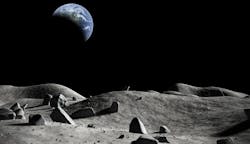NASA Picks Nine Companies for $2.6 Billion Moon Payload Program
In its bid to return Americans to the moon via private enterprise, NASA is budgeting as much as $2.6 billion over the next decade for commercial firms to ferry payloads. On Thursday, it announced nine U.S. companies selected as initial bidders.
NASA says that its lunar plans are feasible because it will be a customer for multiple capabilities that commercial players will want to exploit: the ability to land various payload sizes on the moon and to perform micro-gravity research there. NASA Administrator Jim Bridenstine disclosed the Commercial Lunar Payload Services contracts as part of the Trump administration’s efforts to encourage greater commercial investment in space exploration.
“We want to be one customer of many customers in a robust marketplace between the earth and the moon, and we want multiple providers that are competing on cost and innovations so that we as NASA can do more than we’ve ever been able to do before,” Bridenstine said.
The open question, of course, is how much commercial demand exists for access to the moon. To date, only nation-states have mounted the extremely expensive programs necessary to orbit or land there. (China landed its first mission in 2013.)
NASA is pursuing a dual path of building a lunar orbital platform and returning astronauts to the moon in the mid-2020s, all aimed at eventually sending humans to Mars. The difference between this moon mission and NASA’s earlier Apollo program, however, would be establishing a permanent research presence in deep space. The Apollo era ended in December 1972.
The space agency foresees an intermittent human presence on the moon within a decade, joining landers and rovers working there, Bridenstine said, citing a planned “open architecture” that would allow for a sustained ecosystem among Earth, the moon and a planned lunar gateway orbiting the moon.
Where the funding for this vision of America’s new space era will come from is unclear. NASA’s current annual budget of $20 billion could be hard pressed to support the needed work on human missions to both the moon and Mars.
Among the nine, mostly small start-up companies picked by NASA is one huge defense contractor, Lockheed Martin Corp. They are among the first eligible bidders for NASA contracts to provide launch and landing services, payload integration and other instruments for lunar research. The first missions may fly next year, NASA said.
The full list of selected companies:
· Astrobotic Technology Inc.: Pittsburgh
· Deep Space Systems: Littleton, Colo.
· Draper: Cambridge, Mass.
· Firefly Aerospace Inc.: Cedar Park, Texas
· Intuitive Machines LLC: Houston
· Lockheed Martin Space: Littleton, Colo.
· Masten Space Systems Inc.: Mojave, Calif.
· Moon Express: Cape Canaveral, Florida· Orbit Beyond: Edison, N.J.
By Justin Bachman
About the Author
Bloomberg
Licensed content from Bloomberg, copyright 2016.
